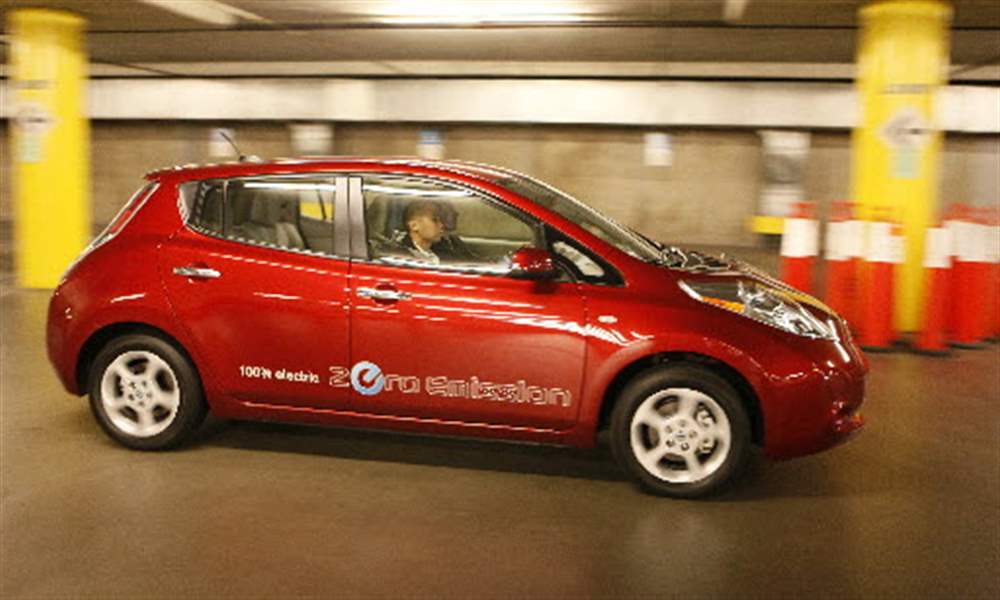
Electric cars' load on power grid poses quandary for utilities
11/28/2010
The Nissan Leaf, a 100% electric car, zero emissions vehicle, is test driven at the 2010 Los Angeles Auto Show.
NEW YORK - The first mass-market electric cars go on sale next month, and the nation's electric utilities couldn't be more thrilled - or worried.
Plugged into a socket, an electric car can draw as much power as a small house. The surge in demand could knock out power to a home or a neighborhood.
That has utilities in parts of California, Texas, and North Carolina scrambling to upgrade transformers and other equipment in neighborhoods where the Nissan Leaf and Chevrolet Volt are expected to be in high demand.
Not since air conditioning spread across the country in the 1950s and 1960s has the power industry faced such a growth opportunity. Last year, Americans spent $325 billion on gasoline, and utilities would love even a small piece of that market.
The main obstacles to wide-scale use of electric cars are high vehicle cost and limited range, at least until a network of charging stations is built. But utility executives fret that difficulties keeping the lights on in the first wave of buying could slow the niche's growth. "You never get a second chance to make a first impression," said Mike Rowand, Duke Energy Corp. head of electric vehicle planning.
Auto executives say it's inevitable that utilities will experience some difficulties early on. "We are all going to be a lot smarter two years from now," said Mark Perry, director of product planning for Nissan North America.

The Nissan Leaf, a 100% electric car, zero emissions vehicle, is test driven at the 2010 Los Angeles Auto Show.
Electric cars run on big batteries that are charged by plugging into a standard wall socket or a more powerful charging station.
A combined 30,000 Nissan Leafs and General Motors Co.'s Chevrolet Volts are expected to be sold over the next year. Over the next two years, every other major automaker also plans to offer electric cars.
Governments are promoting the costly technology as a way to reduce dependence on foreign oil, cut greenhouse gas emissions, and improve air quality. Congress is offering electric-car buyers a $7,500 tax credit, and some states and cities provide additional subsidies that can total $8,000. The Leaf sells for $33,000, the Volt for $41,000.
Electric cars produce no emissions, but the electricity that charges them is made mostly from fossil fuels such as coal and natural gas that do put out emissions. Still, electric cars produce only about one-third the greenhouse gas emissions, on average, of a similarly sized car that runs on gasoline, according to the Natural Resources Defense Council.
Driving 10,000 miles on electricity will use about 2,500 kilowatt-hours, or 20 percent more than the average annual consumption of U.S. homes. At an average rate of 11 cents per kilowatt-hour, that's $275 for a year of fuel, equivalent to about 70 cents a gallon of gasoline.
“Electric vehicles have the potential to completely transform our business,” says David Owens, executive vice president of the Edison Electric Institute, a trade group.
Nationwide, utilities have enough plants and equipment to power hundreds of thousands of electric cars. Problems could crop up long before that many are sold, though, because of a phenomenon car makers and utilities call clustering.
Electric vehicle clusters are expected in neighborhoods where:
wGenerous subsidies are offered by states and localities
wWeather is mild, because batteries tend to perform better in warmer climates
wHigh-income and environmentally conscious commuters live
So although states such as North Dakota and Montana may see very few electric cars, California cities including Santa Monica, Santa Barbara, and Monrovia could have several vehicles on a block. Southern California Edison Co. expects to be charging 100,000 cars by 2015. California has set a goal of 1 million electric vehicles by 2020.
Progress Energy Inc. is expecting electric car clusters to form in Raleigh, Cary, and Asheville, N.C., and around Orlando and Tampa, Fla. Duke Energy is expecting the same in Charlotte and Indianapolis. The entire territory of Texas' Austin Energy is expected to be an electric-vehicle hot spot.
When plugged into a standard 120-volt socket, an electric car will draw 1,500 watts. By comparison, a medium-sized air conditioner or a countertop microwave oven draws about 1,000 watts.
But the car can be charged more rapidly, and therefore draw more power, when plugged into a home charging station. The first Leafs and Volts can draw 3,300 watts, and both Nissan and GM may boost that to 6,600 watts. The Tesla Roadster, an electric sports car with a huge battery, can draw 16,800 watts, the equivalent of 280 60-watt light bulbs.
Transformers that distribute power from the electrical grid to homes are often designed to handle fewer than a dozen. The added load on a transformer from one or two electric vehicles could cause it to overheat and fail, knocking out power to the block.
The “nightmare” scenario, said Karl Rabago, head of Austin Energy's electric vehicle-readiness program: People come home from work on a hot afternoon, turn on the air conditioner and the plasma television, blend a frozen cocktail, start cooking dinner on an electric stove — and plug their electric cars into a home charging station.
An electric vehicle plugged into a standard wall socket puts less stress on a transformer, but it could trip a circuit breaker if the circuit serves other appliances, cutting power in part of the house.
To head off problems, teams of workers at utilities are gathering information from Nissan and Chevrolet, doing customer surveys, and looking at buying patterns of hybrid gas-electric cars to try to predict where they might see clusters of electric-car buyers.